California’s legal environment is one of the most challenging states in the country for asset protection. Its high litigation rates, creditor-friendly laws, and lack of self-settled spendthrift trust legislation make safeguarding your wealth particularly challenging. Traditional out-of-state asset protection strategies, such as Nevada Asset Protection Trusts (NAPTs), Wyoming Trust, or Delaware Statutory Trusts (DSTs), often fail to provide the necessary security in California.
This article explains the unique challenges Californians face and why the Bridge Trust® is the most reliable solution for protecting assets from lawsuits and creditors.
Why You Need Asset Protection in California
California is known for its high litigation an complex legal environment. California’s laws are designed to favor creditors, which means that standard asset protection strategies often fall short. Professionals, business owners, and real estate investors are especially vulnerable to these risks:
1. No Self-Settled Trust Protections:
• Under California Probate Code § 15304(a), a spendthrift clause in a self-settled trust does not protect the trust’s assets from the settlor’s creditors. Creditors are allowed to reach assets in trusts where the grantor is also the beneficiary.
• This principle was affirmed in In re Cutter, 398 B.R. 6 (B.A.P. 9th Cir. 2008), where the court allowed creditors to access assets in a self-settled trust because the settlor was also a beneficiary.
2. Fraudulent Transfers:
• Transfers made with the intent to hinder, delay, or defraud creditors are voidable under the Uniform Voidable Transactions Act (Civil Code § 3439.01 et seq.). California is very aggressive in their application of the UVTA.
3. Piercing Trusts:
• California courts frequently invalidate domestic and out-of-state trusts when they conflict with creditor rights, as demonstrated by multiple landmark cases (discussed below).
Without proper planning, your assets can be exposed to lawsuits and other creditor claims.
The Problem with Out-of-State Asset Protection Trusts
Many people turn to out-of-state trusts, such as Nevada Asset Protection Trusst or Wyoming Asset Protection Trusts, believing they will shield their assets. However, California courts do not recognize these trusts, making them ineffective for California residents.
Case Law That Highlights the Risks
1. Kilker v. Stillman (2012):
• What Happened: California invalidated a Nevada Asset Protection Trust, ruling that California’s laws and public policy override Nevada statutes.
LINK TO CASE DOCKET: https://www.leagle.com/decision/In%20CACO%2020121126043
Click this Link for a case summary on Kilker vs. Stillman (2012) https://btblegal.com/blog-articles/f/case-study-kilker-vs-stillman
• Key Lesson: Out-of-state asset protection trusts fail to protect assets in California.
2. In re Cutter (2008):
• What Happened: The court ruled that creditors could access trust assets in a self-settled trust because the settlor was also a beneficiary, invalidating spendthrift protections under Probate Code § 15304(a).
• Key Lesson: Self-settled spendthrift trusts provide no protection in California.
3. In re Huber (2013)
• Case Summary: A bankruptcy court invalidated an Alaska trust, showing how even strong out-of-state statutes fail in creditor-friendly jurisdictions like California.
• Lesson: The grantor’s state of residence takes precedence over the trust’s governing law.
4. Dahl v. Dahl (2015)
• Case Summary: A trust was invalidated due to the grantor retaining control, exposing assets to creditor claims.
• Lesson: Trusts must be structured carefully to avoid creditor access.
What these cases show is that California is a hostile environment for asset protection trusts.
Why the Bridge Trust® is the Best Strategy for Californians
The Bridge Trust® is a hybrid solution that combines the benefits of domestic and offshore trusts. It is designed to overcome California’s creditor-friendly laws and provide maximum asset protection.
How the Bridge Trust® Works
• The Bridge Trust® begins as a domestic trust, ensuring compliance with California laws.
• In the event of a legal threat, the trust seamlessly transitions to its registered offshore status to jurisdictions like the Cook Islands, where creditor claims are much harder to enforce.
Key Benefits of the Bridge Trust®
1. California Compatibility:
• The Bridge Trust® avoids the pitfalls of out-of-state trusts and operates within California’s legal framework.
2. Offshore Protections:
Once transitioned offshore, the trust benefits from:
• Short statutes of limitations.
• High burdens of proof for creditors.
• Non-recognition of U.S. court orders or judgments.
3. Control and Flexibility:
• You maintain control of your assets during normal circumstances while enjoying enhanced protection during legal threats.
4. Avoids Fraudulent Transfer Risks:
• The hybrid structure reduces the risk of fraudulent transfer claims, ensuring greater compliance and supports transparency.
Practical Steps for Protecting Your Assets
If you want to protect your wealth in California, here’s what you need to do:
1. Understand the Limitations of Domestic Trusts
• California Probate Code § 15304 ensures that self-settled spendthrift trusts offer no protection. Cases like In re Cutter (2008) highlight this vulnerability.
2. Avoid Out-of-State Trusts
• As shown in Kilker v. Stillman (2012) , Nevada, Wyoming, and other out-of-state asset protection trusts fail against California creditors. California Courts will just ignore them.
3. Consider Offshore Options
• Offshore jurisdictions, like the Cook Islands, offer unmatched protections, including non-recognition of U.S. judgments and high barriers for creditors.
4. Use the Hybrid Bridge Trust®
• By combining domestic accessibility with offshore strength, the Bridge Trust® is the most effective strategy for California residents.
Recapping the Relevant Statutes and Case Law Supporting the use of The Bridge Trust®
• California Probate Code § 15304: Prevents self-settled spendthrift trust protections.
• Civil Code § 3439.01 et seq. (UVTA): Allows creditors to void fraudulent transfers.
• In re Cutter (2008): Demonstrates that self-settled trusts provide no asset protection under § 15304(a).
• Kilker v. Stillman (2012): Shows why California courts reject out-of-state trusts.
• In re Schwarzkopf (2010): Highlight the importance of limiting grantor control to avoid trust piercing.
Conclusion: Protect Your Assets in California with the Bridge Trust®
California’s creditor-friendly laws make it one of the hardest states for asset protection. Out-of-state and domestic trusts fail to provide adequate security, as demonstrated by numerous cases. Understanding how to protect your assets from lawsuits in California is crucial for anyone looking to safeguard their financial future. The Bridge Trust®, however, offers a hybrid solution that combines domestic tax flexibility with the robust asset protection strength of offshore jurisdictions. If you’re serious about safeguarding your assets, the Bridge Trust® is the best option for California residents.
Call us for a FREE consultation at (888) 773-9399.
By: Brian T. Bradley, Esq.




